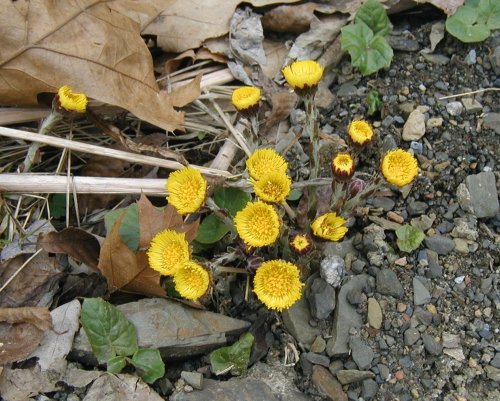Herb of the Month: Coltsfoot (Tussilago Farfara)

Coltsfoot : April Herbal Focus
So, as we walk through the woods in April and early may, we can see small yellow flowers that look like dandelions, but have a scaly, reddish-brown stem, and no leaves present. This amazing flower, that likes moist, shady places like the edge of a forest, is called Coltsfoot, or it’s Latin name, Tusilago Farfara. It is easily distinguished from dandelion, as its stem is not smooth, green and hollow, but red-brown, scaly and solid in the center. The flowers appear between February and April, and when the leaves come up, one can see the flower stems gone to seed, but no flower present. The leaves are what gives it the common name of coltsfoot; the are in the shape of a hoof. They are broad, flat, and smooth, with a lighter green on the underside of the leaf.
A friend of mine, who works with Plant Spirits, says that this Latin name gives us a good clue as to what the plant is good for. The Latin word for “cough” is “tussis”; and so, this plant “sends a cold far, far away”. It made me laugh to hear her put it like that, but it truly is a very effective expectorant, helping us to expel mucus and the bacteria causing the congestion. The name “Farfarus” was an old name for White poplar, whose leaves had a very similar shape.
Many old herbalists recommended the smoking of the hoof-shaped leaves for bronchitis and asthma symptoms as it would help to open the bronchial tubes (a similar action to puffers today). The smoking of this herb has none of the same effects as smoking something like tobacco, so it is an excellent way to utilize this gift from Mother Nature. The indigenous tribe of North America have long used coltsfoot leaves to roll herbal ‘cigarettes’, as paper was not something they had at their disposal. Combined with mullien, coltsfoot was used to treat acute lung conditions.
I have recently obtained a copy of an excellent herbal, called Culpepper’s Complete Herbal. It was written by Nicholas Culpepper, in England, during the reign of Elizabeth I. (1653) In his book, he says about Coltsfoot: ‘The fresh leaves, or juice, or syrup thereof, is good for a bad dry cough, or wheezing and shortness of breath. The dry leaves are best for those who have their rheums and distillations upon their lungs causing a cough: for which also the dried leaves taken as tobacco, or the root is very good. The distilled water hereof simply or with elder-flowers or nightshade is a singularly good remedy against all agues, to drink 2 OZ. at a time and apply cloths wet therein to the head and stomach, which also does much good being applied to any hot swellings or inflammations. It helpeth St. Anthony’s fire (erysypelas) and burnings, and is singular good to take away wheals.’
As one can see, this herb was used for many applications. I personally find that a syrup, or a tincture is very effective for getting rid of a cough or cold.
To prepare your own medicines with Coltsfoot:
To use Coltsfoot for tisanes and infusions, gather flowers in March or April, and bring them home. Lay them out somewhere cool and dark, preferably with good air circulation. I sometimes just use sheets of paper towel and carefully stack them, but screens are better for laying things out to dry. Re-using an old window screen is a good frugal way to approach this.
When June comes around, go back to the site where you gathered the flowers and look for the large, hoof-shaped leaves. Gathering both flowers and leaves, and even some of the rhizomes (roots) is ideal, because different constituents are in different parts of the plant. Once you have gathered your plant material, take it home and wash it, gently patting dry before use.
To prepare an herbal honey:
Susun Weed, a wonderful herbalist from New York State, has posted this excellent video about preparing Coltsfoot Honey; which is especially helpful for children with a cough.
Gather a jar-full of fresh flowers, packing them into the jar loosely. Fill with unpasteurized honey, stirring with a chopstick or a twig as the honey settles down into the jar. Cap tightly and allow to sit in the sun (a windowsill is a great spot) for up to 6 weeks before use. (Though Susun did say that even after 48 hours, this infused honey can be taken with positive effect.) It is not necessary to strain out the herbs, especially if using the honey to sweeten a tisane. Just spoon some honey with a few flowers into your tea, and enjoy.
Dosage: Children; 1 teaspoon of herbal honey, three times per day. Adults; 1 tablespoon of herbal honey, three times per day.
To prepare a tincture:
Same procedure as above, gather a jar-full of fresh flowers and loosely pack them into the jar. Fill to the top with a strong liquor (preferably 80 proof or higher). Vodka works well, but some individuals prefer other flavours and use brandy or rum. Fill the jar right to the top, making sure all plant parts ore covered. Cap tightly and label with the date and herb name. After 6 weeks, strain through cheesecloth or a fine strainer, and label. Tinctures have a shelf-life of up to two years, so a little goes a long way.
Dosage: 15-30 drops in a small amount of water, 3 times per day. Used for acute cold symptoms. If the cold lingers for more than two weeks, discontinue use of coltsfoot and consult a medical professional.
